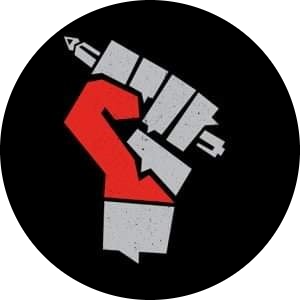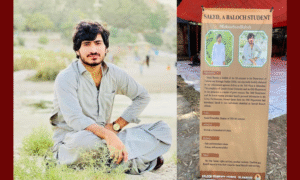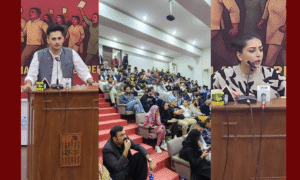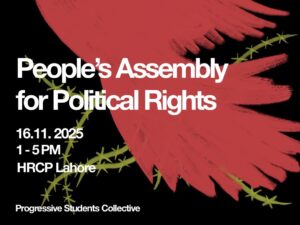It’s hard to imagine students attacking police with Molotovs and improvised bombs or universities getting occupied and run by students; however, the history of the 20th century shows that students did not take John Lennon seriously when he wrote, “Don’t you know it’s gonna be All right?” From Vietnam to Mexico and Iran to the US, students made it clear that they “want a revolution.”
In Pakistan, too, a radical student movement emerged in the 1950s and culminated in the revolution of 1968–a revolution brought about by the solidarity between students and the working class–which toppled the dictatorship of Ayub Khan. However, the revolution could not go beyond the confines of the capitalist mode of production, and its failure, much like the other revolutions of 68, was partly due to a lack of ideological clarity and partly due to the mistakes of the mainstream Left, which produced the space for the populism of Zulfiqar Ali Bhutto. Bhutto era is often mistakenly considered the “golden era of student politics in Pakistan”; however, a close look shows us that despite his leftist rhetoric, he was reluctant to lift the ban on student unions and didn’t hesitate to initiate a crackdown on left-wing workers and student groups that criticized his reforms and created Peoples’ Student Federation (PSF) to counter far-Left.
As Walter Benjamin, while reviewing Enerst Jungers, Theories of German Fascism, wrote, “Behind every fascism, there is a failed revolution.” The failure of the revolution in 68 led to the dictatorship of Zia ul Haq, who banned student unions across the country. In this milieu, all the spaces shrank for progressive and left-leaning student organizations, and a conducive environment was created for conservative Islamist tendencies on the campuses. The democratic government that came after the dictatorial reign of Zia also continued the same policy. This ban on student unions, followed by the fall of the Berlin Wall and the collapse of the Soviet Union, which was widely celebrated as the “end of history” by bourgeois idealogues, further pushed progressive student politics into the abyss.
This fuss and hullabaloo of the ultimate victory of capitalism didn’t last long as at the turn of the century, the system met with the crisis of 1998, followed by the dot-com bust of 2001 and in 2007 with the worst recession since the Great Depression of 1930s which lead to a new wave of protests in the form of Occupy Wall Street movement against the way the crisis was handled by bailing out finance capital and Arab Spring which started in Tunisia as a protest against high unemployment, food inflation, and corruption.
In Pakistan, too, the global economic crisis generated unrest among the students and the working class, but with no alternatives for the youth to turn to, PTI emerged, and Khan filled the political vacuum through his populist slogans of curbing corruption and Pakistan’s ending reliance on IMF (in India, Anna Hazare played a similar role though without the backing of the state), however, after coming to power he continued the policies of IMF which alienated the progressive section of his support base which was mainly constituted by the university going students.
However, apart from this mainstream horizontal comradeship of youth under the PTI banner, another movement was in the making. It was constituted by the students who had to move from the peripheries to the metropolitan centers as a result of the war on terrorism and lack of educational facilities.
This period also saw the resurgence of student protests globally; the JNU movement, which started against capital punishment meted out to Afzal Guru in India and went on demand FeesMustFall (a slogan that became famous in 2015 protests in South Africa), had a significant impact on the politically conscious sections of students in Pakistan. Following their Indian comrades, students also began to protest against the fee hikes under PTI and the ban on student unions in Pakistan.
The emergence of PTM in the aftermath of the murder of Naqeebullah Mehsud and the way the state reacted to it generated solidarity across the progressive sections of students, ultimately leading to the resurgence of the student movement in the form of countrywide marches; however, despite the initial success, it failed to achieve anything but empty promises. However, this is not something one should mourn – the more important task is to reflect on this failure and ask why these movements fail.
The answer to this question lies in the fact that the demands of the students cannot be met in this current economic system without going beyond the students’ movement, and for that, students need to unite their destiny with the working class; the only social class capable of emancipating itself and thus emancipating the rest of society.
Students’ Movement and Class Composition
Unlike the generationalist approach, which is anchored in an analysis that focuses on the generational character of the student movement, especially linking it to youth rebellion, or the classist approach, which dismisses it as a “middle class” phenomenon, the Marxian understanding of the student movement presupposes a Marxian conception of social movement and society in general. In light of the dialectical method, it is impossible to analyze the student movement separately from society and its determinations. Thus, if it is certain that this movement can be characterized as a totality, it is equally certain that it is part of a larger totality, that is, capitalist society. Thus, we understand social movement as a mobilization of social groups derived from certain social situations that generate social dissatisfaction, a sense of belonging, and certain objectives.
The student movement encompasses all these elements and is, therefore, a specific social movement. The basic social group of the student movement is, obviously, students. It is their specific social situation (student status) that generates this social group. Here, it is essential to understand that the student movement is not the same as students. Student is the description of a certain activity that is itself transitory and non-determinant of an individual. From a Marxian perspective, one of the pillars of the materialist analysis of society and its contradictions is the idea that class struggle is the engine of history. Thus, the dynamics of this particular social conflict become of great analytical importance since societal transformations permeate the struggles of the social classes in a given society and have consequences for other social relations, such as conflicts between social movement groups.
The social base of the student movement, as we have already stated, is the students who are not homogeneous. A student has a certain class belonging, as he can be linked to the bourgeoisie, proletariat, peasant, or other social classes. From this, it follows that the student movement is essentially polyclassist (except for a few instances where it may present monoclassist tendencies), which, as we will see below, has important political implications.
Students Movement Beyond Student Movement
The importance of the demands of the present student movement around the restoration of the student union and fee hikes cannot be denied. However, it is important to understand that though these demands may appear apolitical, they are fundamentally political and can’t be won within the capitalist system, especially given that even in advanced capitalist economies, the reforms won by the working class and students in the 60s are being backrolled. This problem becomes even more acute in a backward capitalist country like Pakistan, where the state following the IMF policies wants to cut the education budget further and privatize schools. Therefore, going beyond the student movement becomes the pressing task before the student movement today, but this does not entail that students alone as a revolutionary subject, as popularized by Mandel, can overthrow this system. Such an analysis fails to see that students do not constitute a distinct social class but rather act according to their class interests in the face of major social crises, and they have a tendency historically to join one side or the other of the barricade.
Only the working class has its class interest in fighting against austerity and privatization; therefore, the student movement can only be successful in overthrowing by standing in solidarity with the working class and by having a clearly mapped out revolutionary ideology that is free of all the illusions of reformism.




